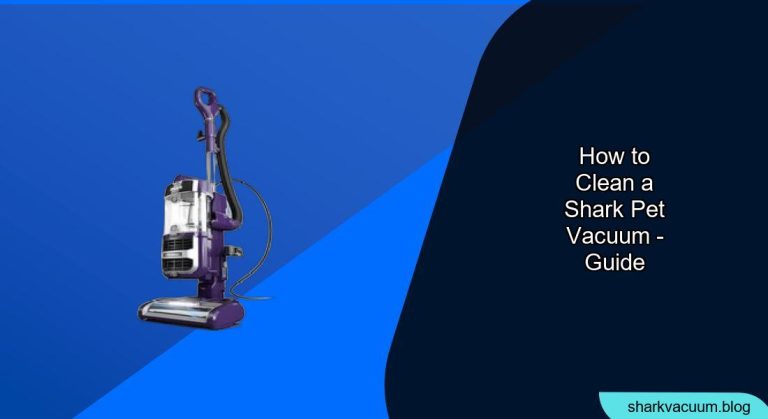Tired of your Shark pet vacuum losing suction or emitting a strange odor? Regular cleaning is essential to keep your Shark vacuum performing at its best, especially when dealing with pet hair and dander. This guide provides a step-by-step approach to cleaning your Shark pet vacuum, ensuring optimal performance and longevity.
A Shark pet vacuum is a powerful tool for keeping your home clean, but its effectiveness relies on proper maintenance. Pet hair, dust, and debris can quickly clog filters and brush rolls, reducing suction power and potentially damaging the motor. By following a consistent cleaning routine, you can prevent these issues, extend the life of your vacuum, and maintain a hygienic home environment for you and your furry friends. This guide will walk you through each component of your Shark vacuum, providing detailed instructions and helpful tips to keep it running smoothly.
Table of Contents
Emptying the Dust Cup

The dust cup is the primary collection point for dirt and debris, so emptying it regularly is crucial.
- Detach the Dust Cup: Locate the release button on the dust cup, usually near the handle or body of the vacuum. Press the button and gently pull the dust cup away from the vacuum.
- Empty the Contents: Hold the dust cup over a trash can. Press the release button on the bottom of the dust cup to open the trapdoor and empty the contents. For a more thorough clean, you can also open the top of the dust cup and remove any remaining debris.
- Clean the Dust Cup: Rinse the dust cup with warm water and mild soap, if needed. Ensure the dust cup is completely dry before reattaching it to the vacuum. Never operate the vacuum with a damp dust cup.
- Reattach the Dust Cup: Align the dust cup with the vacuum body and push it until it clicks into place.
Cleaning the Filters
Shark vacuums typically have multiple filters that trap fine dust and allergens. Cleaning these filters is essential for maintaining suction power and air quality.
- Locate the Filters: Refer to your Shark vacuum’s user manual to identify the location of the pre-motor and post-motor filters. Pre-motor filters are usually located near the dust cup, while the post-motor filter is often found near the motor housing.
- Remove the Filters: Carefully remove the filters from their compartments.
- Clean the Pre-Motor Filters: Tap the pre-motor filters gently over a trash can to remove loose dust and debris. Rinse the filters with warm water until the water runs clear. Allow the filters to air dry completely for at least 24 hours before reinserting them.
- Clean the Post-Motor Filter: The post-motor filter (usually a HEPA filter) is more delicate. Tap it gently to remove loose dust. Do not wash the HEPA filter unless specifically instructed by the manufacturer. If washing is allowed, follow the same drying procedure as the pre-motor filters.
- Reinstall the Filters: Once the filters are completely dry, reinstall them into their respective compartments. Ensure they are properly seated to prevent air leaks.
Removing Hair and Debris from the Brush Roll
Hair and string can easily become tangled around the brush roll, hindering its ability to agitate and lift dirt.
- Turn Off and Unplug the Vacuum: Always disconnect the vacuum from the power outlet before performing any maintenance.
- Access the Brush Roll: Depending on your Shark model, you may need to remove a cover plate or access panel to reach the brush roll. Refer to your user manual for specific instructions.
- Remove Tangled Hair and Debris: Use scissors or a seam ripper to carefully cut away any tangled hair, string, or fibers from the brush roll. Be careful not to damage the bristles.
- Clean the Brush Roll Housing: Remove any remaining debris from the brush roll housing using a small brush or cloth.
- Reinstall the Brush Roll: Place the brush roll back into its housing, ensuring it is properly aligned. Reattach the cover plate or access panel.
Checking and Clearing Hoses and Attachments

Clogs in the hoses and attachments can also restrict airflow and reduce suction power.
- Detach Hoses and Attachments: Disconnect the hoses and attachments from the vacuum body.
- Inspect for Blockages: Visually inspect the hoses and attachments for any visible obstructions.
- Clear Blockages: Use a broom handle or similar tool to gently push any blockages through the hoses and attachments.
- Rinse Attachments: Wash the attachments with warm water and mild soap, if needed. Ensure they are completely dry before reattaching them to the vacuum.
- Reattach Hoses and Attachments: Reconnect the hoses and attachments to the vacuum body, ensuring they are securely fastened.
Cleaning the Nozzle

The vacuum nozzle can also accumulate debris that affects performance.
- Detach the Nozzle: Most Shark vacuums have a release button or lever to detach the nozzle from the wand.
- Inspect for Blockages: Check the nozzle opening for any obstructions, such as large debris or tangled hair.
- Remove Debris: Use your fingers or a tool to carefully remove any blockages from the nozzle.
- Wipe Clean: Wipe the exterior of the nozzle with a damp cloth to remove any dirt or grime.
- Reattach the Nozzle: Reconnect the nozzle to the wand until it clicks into place.
Troubleshooting Guide
- Loss of Suction: Check the dust cup, filters, hoses, and brush roll for clogs or obstructions.
- Unusual Noises: Inspect the brush roll for tangled debris or damaged parts.
- Overheating: Ensure the filters are clean and the airflow is not restricted.
- Vacuum Won’t Turn On: Check the power cord and outlet. Also, make sure all components are properly assembled.
- Bad Odor: Clean the dust cup and filters thoroughly. You can also use a vacuum deodorizer.
Tips, Warnings, and Best Practices
- Frequency: Empty the dust cup after each use and clean the filters every 1-3 months, depending on usage.
- Drying: Always allow filters to dry completely before reinstalling them.
- Replacement: Replace filters every 6-12 months or as needed.
- Safety: Always unplug the vacuum before performing any maintenance.
- User Manual: Refer to your Shark vacuum’s user manual for specific instructions and maintenance recommendations.
FAQ Section
How often should I replace the filters on my Shark pet vacuum?
Replace the filters on your Shark pet vacuum every 6-12 months, or more frequently if you notice a decrease in suction power or if the filters appear visibly dirty. Regular filter replacement ensures optimal performance and prevents damage to the motor.
What is the best way to remove pet hair from the brush roll?
Use scissors or a seam ripper to carefully cut away tangled pet hair from the brush roll. Be gentle and avoid damaging the bristles. Regularly cleaning the brush roll will prevent clogs and maintain effective cleaning performance.
Can I wash the HEPA filter in my Shark vacuum?
Check your user manual. Some HEPA filters can be gently rinsed with water, while others should only be tapped clean. Always allow the HEPA filter to air dry completely before reinstalling it to prevent mold growth and maintain its effectiveness.
Why is my Shark vacuum losing suction even after cleaning the dust cup?
A loss of suction can be due to clogged filters, a blocked hose, or a tangled brush roll. Check each of these components for obstructions and clean them thoroughly. If the problem persists, consult your vacuum’s user manual or contact Shark customer support.
What can I do to prevent my Shark vacuum from smelling bad?
Regularly empty and clean the dust cup and filters. You can also use a vacuum deodorizer or place a dryer sheet in the dust cup to help neutralize odors. Additionally, ensure that you are not vacuuming up anything that could cause a lingering smell.
How do I know if my Shark vacuum needs professional servicing?
If you experience persistent issues such as motor problems, electrical malfunctions, or irreparable damage to components, it may be time for professional servicing. Contact a qualified appliance repair technician or Shark customer support for assistance.
Conclusion
Cleaning your Shark pet vacuum is a straightforward process that can significantly improve its performance and extend its lifespan. By following these steps regularly, you’ll ensure that your vacuum continues to effectively remove pet hair, dust, and debris, keeping your home clean and healthy. Make sure you regularly clean your Shark pet vacuum to keep your home in tip top shape!







